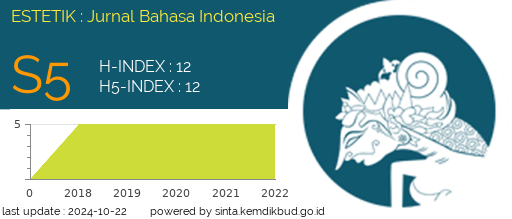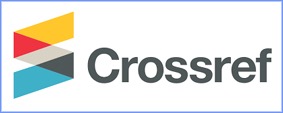Campur Kode dan ALih Kode pada Komunikasi Sehari-hari Masyarakat di Sekitar Tahura Bengkulu Tengah
DOI:
https://doi.org/10.29240/estetik.v2i1.900Abstract
Abstract: This study aims to describe mixed code and code transfer communicating in the daily activities of the Lembak people in the Tahura area and the use of the Tahura area.The scope of this research is non formal activities. Partiipants in this study are, Adolescents, adult and parents, with education ranging from those who are not in school, high school and university. Respondents in this study had different jobs ranging from students, housewife, food sellers, and famers. This research refers to the theory put forward by (Chaer and Agustina 1995:4), Appeal (in Suwito, 1983:5), Nababan ( in Chaer and Agustina, 2004:3) about sociolinguistics. The method used is descriptive qualitative method. After conducting research, the authors found data including, the are four languages used by the Lembak people in Tahura Communicate, namely the Lembak language, Bengkulu Malay Language, Rejang language, an javanese. The use of these four languages is in accordance with the context and participants As a result of languages other than Lembak, code and code switching emerged when poeple communicated in their daily activities.
Keywords: Mixed Code, Transfer Code
Downloads
References
DAFTAR PUSTAKA
Adiel. 2009. Alih Kode, Campur Kode, Interferensi.www. http:/ ilmu linguistik- sosiolinguistik.co.id / (diakses 3 Januari 2011).
Chaer, Abdul, dkk.2004. Sosiolinguistik Perkembangan Awal, Jakarta:PT. Rineka Cipta
Djajasudarma, T. Fatimah. 2006. Metode Linguistik Ancangan Metode Penelitian dan Kajian, Bandung: Refika Aditama.
Pemilihan bahasa dalam komunikasi. Jakarta: PT. Rineka Cipta.
Fitri Mediana Desi.2002.Alih Kode dan Campur Kode dalam Bahasa Lembak, Bengkulu: Universitas Bengkulu.
Furchan, Arief.1991. Metode Penelitian Kualitatif, Bandung: Bineka Cipta.
Grosjean.1982. Pemilihan bahasa sesuai konteks. Jakarta: Bineka Cipta.
Ibrahim, syukur. 1993. Kapita Selekta Sosiolinguistik.Surabaya: Usaha Nasional.
Ibrahim, syukur.1979. Prinsip dan Metode Linguistik Historis, Surabaya: Usaha Nasional.
J.W.M. Verhaar. 1996. Asas – Asas Linguistik Umum. Yogyakarta: Gadjah Mada Univeristy Press.
Minarti Eli. 2004. Bilingualisme dalam Komunikasi Lisan Masyarakat Lembak di Kecamatan Kota Padang Kabupaten Rejang Lebong, Bengkulu: Universitas Bengkulu.
Moleong, Lexy J. 1988. Metode Penelitian Kualitatif, Bandung: PT. Remaja Rosda Karya.
Nababan, PWJ.1991 Sosiolinguistik Suatu Pengantar, Jakarta: Gramedia Pustaka Utama.
Pusat Bahasa. 2009. Pedoman Penelitian Sosiolinguistik, Jakarta: Pusat Bahasa
Sadiki, Malik. 2008. Konteks situasi komunikasi..www. http:// jurnal- linguistik.com (diakses 10 Januaru 2011).
Sandra, Lita. 2010. Sosiolinguistik di Masyarakat.www.http://Artikel Sosio – Linguistik, com/(diakses 3 Januari 2011).
Suwito, 1983. Artikel Sosiolinguistik. www. Http:// Artikel – suwito – sosio, co.id/( di akses( 7 januari 2011)
Yummi, Yulius. 2010. Artikel Sosiolinguistik.www.http//sosiolinguitik.co.id, (diakses 3 Januari 2011).
Downloads
Published
How to Cite
Issue
Section
Citation Check
License
Authors who publish with ESTETIK : Jurnal Bahasa Indonesia agree to the following terms:
- Authors retain copyright and grant the journal right of first publication with the work simultaneously licensed under a Creative Commons Attribution-NonCommercial-ShareAlike 4.0 International License (CC BY-NC-SA 4.0) that allows others to share the work with an acknowledgment of the work's authorship and initial publication in this journal.
- Authors are able to enter into separate, additional contractual arrangements for the non-exclusive distribution of the journal's published version of the work (e.g., post it to an institutional repository or publish it in a book), with an acknowledgment of its initial publication in this journal.
- Authors are permitted and encouraged to post their work online (e.g., in institutional repositories or on their website) prior to and during the submission process, as it can lead to productive exchanges, as well as earlier and greater citation of published work (See The Effect of Open Access).






